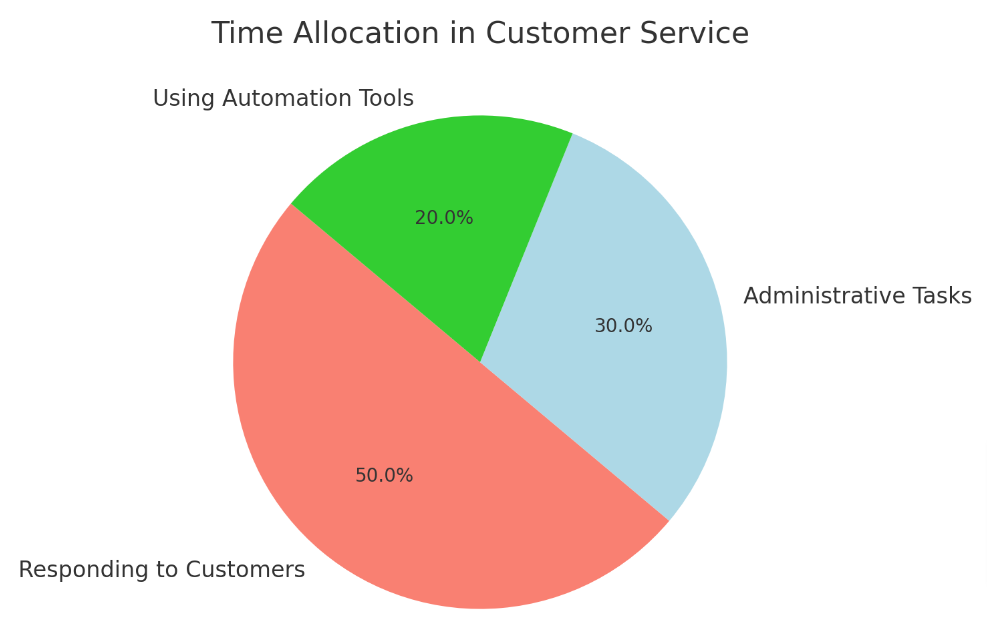Enhancing Efficiency: Techniques for Quicker Live Chat Responses
Waiting too long for a live chat reply can be frustrating. Studies show fast responses are key to keeping customers happy. This blog will guide you through streamlining your workflows to speed up those replies, ensuring your customer service stands out.
Don’t let slow chats be your downfall!
Key Takeaways
- Fast live chat replies keep customers happy, and streamlining workflows is key to speeding up response times.
- Analyzing current workflows can reveal delays, which businesses can then reduce by simplifying, standardizing, and automating processes.
- Regular training and empowering customer service teams improve agents’ ability to handle inquiries efficiently.
- Incorporating technology like automation tools and integrated systems enhances both the speed and quality of live chat support.
- Continuous monitoring of workflow performance helps identify improvement areas for maintaining high standards in customer service.
The Importance of Streamlining Workflows in Customer Service
Streamlining workflows in customer service helps businesses respond to customers quickly and efficiently. Customers expect fast answers when they reach out for help, and a streamlined process ensures that their issues are addressed without unnecessary delays.
By optimizing customer support workflows, companies can reduce the time agents spend on repetitive tasks, freeing them up to focus on more complex inquiries. This enhances agent performance and leads to higher satisfaction rates among customers.
Efficient service delivery is critical to maintaining a competitive edge in today’s marketplace where response time can be a deal-breaker. Service automation tools play a vital role in achieving this by assisting live chat agents with instant messaging solutions and providing access to an organized knowledge base for faster issue resolution.
As teams employ agile workflow processes, they create an optimized communication channel that improves overall service productivity. With these enhancements in place, businesses are better positioned to foster loyal relationships with clients who value prompt assistance.
Moving forward, let’s explore strategies for streamlining workflows that can further accelerate response times and boost customer experience.
Strategies for Streamlining Workflows
Analyzing current workflows to identify bottlenecks and inefficiencies is the first step in streamlining processes. Simplifying and standardizing workflows helps to create a more structured and efficient system for responding to live chats.
Analyzing Current Workflows
To streamline workflows and speed up live chat response times, it’s crucial to start with a thorough analysis of existing processes. This deep dive into how things currently work helps identify bottlenecks and inefficiencies.
- Map out every step in the current customer support process. Create detailed flowcharts or diagrams that visually represent each phase of the customer interaction cycle.
- Track the time taken at each stage of a live chat conversation. Use this data to spot where delays typically happen and prioritize those areas for improvement.
- Collect feedback from live chat agents. They can provide firsthand insights on workflow challenges and suggest practical solutions based on their experiences.
- Review past live chat logs meticulously. Look for patterns in conversations that could be streamlined with canned responses or automated greetings.
- Examine how different teams interact during a customer support scenario. Ensure handoffs between departments are smooth to prevent any unnecessary hold-ups in resolution time.
- Assess the tools currently in use for managing live chats. Determine if they’re effectively supporting agent performance or if newer, more advanced solutions would help cut down response times.
- Consider how well your team utilizes documentation leverage to resolve issues quickly. An easily accessible knowledge base can greatly reduce time spent searching for information during a chat.
- Check if there is efficient workspace organization within the team’s environment, as cluttered or disorganized spaces can hinder an agent’s ability to find resources promptly when needed.
- Evaluate communication channels used alongside live chat, like email or phone support. Seamless integration of these can significantly improve overall service productivity.
- Identify training gaps that might slow down an agent’s ability to respond swiftly and confidently during customer interactions.
Simplifying and Standardizing Workflows
After dissecting your current workflows, the next step is to make them simpler and more uniform. Simplifying processes helps your team move quicker, while standardization ensures consistency across all customer interactions.
- Cut out unnecessary steps: Review each part of the workflow and remove anything that doesn’t add value. This reduces complexity and speeds up response times.
- Create clear guidelines: Develop standard operating procedures for common questions and scenarios. This allows agents to provide quick and consistent answers.
- Use templates and scripts: Implement pre-written responses for frequently asked questions. Agents can quickly select the best reply, speeding up the live chat process.
- Streamline decision-making: Establish rules for when agents should escalate an issue. Clear protocols save time and avoid confusion.
- Regularly review roles: Make sure every team member knows their responsibilities. Well-defined roles prevent overlap and wasted effort.
- Organize resources effectively: Keep all necessary information accessible in one place. A well-organized knowledge base means faster issue resolution.
- Prioritize tasks logically: Teach agents to handle chats based on urgency or complexity. An efficient prioritization system improves service productivity.
- Simplify software use: Choose user-friendly tools that integrate with your existing systems. Easy-to-use software enhances agent performance without extensive training.
Automating and Integrating Workflows
To improve efficiency, consider automating repetitive tasks such as routing chats to available agents based on skillset and workload. Integration of live chat with customer relationship management (CRM) systems enables agents to access customer data instantly to provide personalized support. Additionally, automated transcripts and logging of chat interactions streamline documentation leverage for faster issue resolution. Moreover, integrating chatbots for handling common queries frees up live agents to focus on more complex issues. Furthermore, automation tools can prompt agents with relevant knowledge base articles during live chats for quicker problem-solving. Next: “Training and Empowering the Team.”
Training and Empowering the Team
Transitioning from automating and integrating workflows to training and empowering the team, here are effective strategies for optimizing agent performance:
- Implement regular training sessions to keep the team updated on the latest customer service techniques and technologies, fostering continuous improvement in customer support efficiency. This ensures that agents are equipped with the knowledge needed to handle diverse customer queries.
- Provide ongoing coaching and mentorship programs to empower agents in their roles, boosting confidence and enhancing their ability to resolve customer issues effectively, leading to improved customer satisfaction.
- Foster a culture of autonomy by encouraging agents to make decisions within defined boundaries, enabling them to address customer needs promptly without having to escalate every issue, thereby accelerating response times.
- Utilize gamification techniques such as leaderboards and rewards for achieving response time targets or high customer satisfaction ratings, fostering healthy competition and boosting agent motivation.
- Offer opportunities for career development and advancement within the customer service team, providing incentives for agents to continuously improve their skills and stay motivated in delivering efficient service.
- Establish clear communication channels within the team, facilitating seamless collaboration and knowledge sharing among agents, leading to enhanced productivity and quicker issue resolution.

Monitoring and Improving Workflows
To maintain efficiency, it is crucial to continuously monitor and improve workflows. This involves:
- Regularly assessing the performance of current workflows to identify bottlenecks or inefficiencies.
- Gathering feedback from team members and customers to pinpoint areas for improvement and possible pain points in the process.
- Implementing changes based on gathered data to streamline operations and enhance productivity.
- Setting up Key Performance Indicators (KPIs) to track progress and ensure continuous improvement.
- Conducting regular reviews and updates of workflows to adapt to changing customer needs and business requirements.
The Role of Technology in Streamlining Workflows
Technology plays a crucial role in improving customer service efficiency, with benefits ranging from enhancing live chat features to investing in training for live chat agents. By leveraging the right tools and technology, companies can significantly accelerate response times and enhance agent performance in delivering quick and efficient customer support.
Benefits of Technology in Improving Customer Service Efficiency
Technology plays a pivotal role in enhancing customer service efficiency. It enables quick access to customer data, aiding agents in providing personalized and prompt solutions. Automation tools streamline repetitive tasks, allowing agents to focus on complex customer issues, ultimately improving response efficiency.
Efficient workspace organization through technology ensures that the right information is at the agent’s fingertips during live chat interactions, leading to quicker issue resolution.
Investing in training for live chat agents on utilizing advanced features of communication platforms further enhances their performance. Additionally, real-time analytics provided by technology allows businesses to continuously monitor and optimize workflows for improved productivity and seamless task management throughout the support process.
Enhancing Live Chat Features
Live chat features can be enhanced by incorporating proactive messaging, AI-powered chatbots for basic queries, and personalized responses to customer issues. These enhancements streamline the customer support process, improving response times and overall service productivity.
An integrated knowledge base allows agents to access relevant information quickly, enabling them to provide accurate and efficient solutions to customer inquiries. Furthermore, implementing real-time analytics helps in monitoring live chat performance and identifying areas for improvement.
Utilizing automation tools in live chat features enables instant messaging solutions that facilitate seamless task management for agents and quick issue resolution for customers. This not only enhances agent performance but also optimizes communication channels, ultimately leading to improved response efficiency and higher customer satisfaction levels.
Investing in Training for Live Chat Agents
Investing in live chat agent training is essential for enhancing customer service efficiency and response times. Well-trained agents can handle customer inquiries effectively, resulting in improved customer satisfaction.
Training equips agents with the necessary skills to navigate complex issues and provide quick, accurate resolutions, consequently optimizing customer support workflows and accelerating response times.
Moreover, investing in training for live chat agents enables them to leverage automation tools more efficiently while utilizing knowledge bases for faster issue resolution. By ensuring that agents are well-versed in seamless task management and equipped with instant messaging solutions, organizations can enhance overall productivity and provide agile workflow processes that lead to improved response efficiency.
The implementation of robust training programs ensures that live chat agents are well-prepared to deliver high-quality service promptly and effectively.
Conclusion
In conclusion, streamlining workflows is crucial for improving live chat response times. By analyzing and simplifying processes, integrating automation tools, and providing effective training, customer service teams can enhance their productivity.
Embracing technology to optimize communication channels and implementing real-time customer assistance are essential for delivering efficient service and boosting customer satisfaction.

